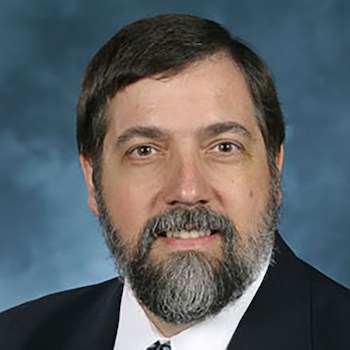Location
Climate & Space Research Building
2455 Hayward Street
Ann Arbor, MI 48109-2143
Phone
Primary Website
Education
- Ph.D., Physics, University of Toledo
- M.S., Physics and Astronomy, University of Toledo
- B.S., Physics, Manhattan College
Professional Service
- Sigma Xi
- Past Director, Research Experiences for Undergraduates (REU), funded by NSF, and providing real-world university research experience for undergraduate majors in mathematics, the physical sciences and engineering
- Editor, Icarus, official journal, Division for Planetary Sciences, AAS
- COMPLEX (Committee on Planetary and Lunar Exploration)
- American Astronomical Society (Division for Planetary Sciences)
- American Geophysical Union
- International Astronomical Union
- American Association for the Advancement of Science
- European Geophysical Union
- Co-Editor, Comets III
- Member and Chair, numerous NASA panels including Planetary Systems Science Management Operations Working Group, CRAF Peer Review Panel, International Halley Watch/PDS Peer Review Panel, NASA Planetary Astronomy Peer Review Panel, Hubble Space Telescope Planetary Science Review Panel
Research Interests
- Planetary Science and Cometary Physics
- Observation and modeling of the spatial and velocity distribution of neutral and ionized cometary gases and dust
- Development of time-dependent multidimensional multispecies fully kinetic models for cometary and planetary satellite atmospheres using Direct Simulation Monte Carlo methods
- Planetary satellite atmospheric structure, escape and interaction with planetary magnetospheres: Io, Europa, Enceladus
- Mars’ exosphere and atmospheric escape
- Venus’ exosphere
- Cometary X-ray observations and study of the excitation mechanism
- First applied Monte Carlo models to study the complicated geometries of free-flow region of cometary atmospheres
- Provided one of the early sets of cometary radical scale lengths for use in determining gas species production rates in comets
- First quantitative observations and analysis of the spatial distribution of water and carbon monoxide ions in the heads and inner tails of comets
- With a colleague, provided the complete self-consistent description tying together the underlying physics of the dynamics of the inner cometary coma outflow, dominated by water photochemistry, with the appearance and velocity distribution of the hydrogen coma of comets, and how these change with the size of the comet and its distance from the sun
- Part of the group that was the first to simulate cometary X-ray production by charge exchange excitation
- With colleagues, demonstrated conclusive evidence from ground-based images of comet Hyakutake that fragments of the nucleus traveling down the tail were providing an extended source of gases which collided with the main coma outflow
Awards
- Asteroid 17061 Mikecombi, named in honor of his contributions to the study of cometary atmospheres, 2005
- Distinguished Research Scientist Award, U-M, 2003
- Outstanding Research Scientist Award, U-M, College of Engineering, 1996-1997
- Editor’s Letter of Commendation, planetary science journal Icarus, 1991 and 1992
- University of Toledo, John J. Turin Outstanding Career Accomplishments Award
- Freeman D. Miller Collegiate Research Professorship
- Co-Investigator, Visible and Infrared Thermal Imaging Spectrometer (VIRTIS) team, European Space Agency’s Rosetta mission to comet 67P/Churyumov-Gerasimenko
- Co-Investigator, Rosetta Orbiter Spectrometer for Ion and Neutral Analysis (ROSINA) team, European Space Agency’s Rosetta mission to comet 67P/Churyumov-Gerasimenko
- Participating Scientist on the MAVEN Mars mission
- Team Member, Visual and Infrared Mapping Spectrometer instrument, NASA’s Comet Rendezvous Asteroid Flyby Mission
- Guest Observer, International Ultraviolet Explorer satellite
- Guest Observer, Hubble Space Telescope (HST) involving ultraviolet spectroscopy and imaging of the 1996 bright comet Hyakutake
- Guest Investigator, observing campaign of the Solar Wind Anisotropies (SWAN) instrument, Solar and Heliospheric Observatory (SOHO) satellite (SWAN pictures)
- European Space Agency Certificate in Recognition for Outstanding Contribution to the ESA Rosetta Mission
- NASA RHG Exceptional Achievement for Science for MAVEN
- NASA Group Achievement Award to MAVEN Science Team
- Certificate of Appreciation MAVEN Mission
- NASA Group Achievement Award to University of Michigan Rosetta Modeling Team
- NASA Group Achievement Award to MAVEN Mission Team for unlocking the mysteries of Mars atmosphere loss through exceptional operation and utilization of MAVEN
- University of Michigan, Award for Service on SACUA
